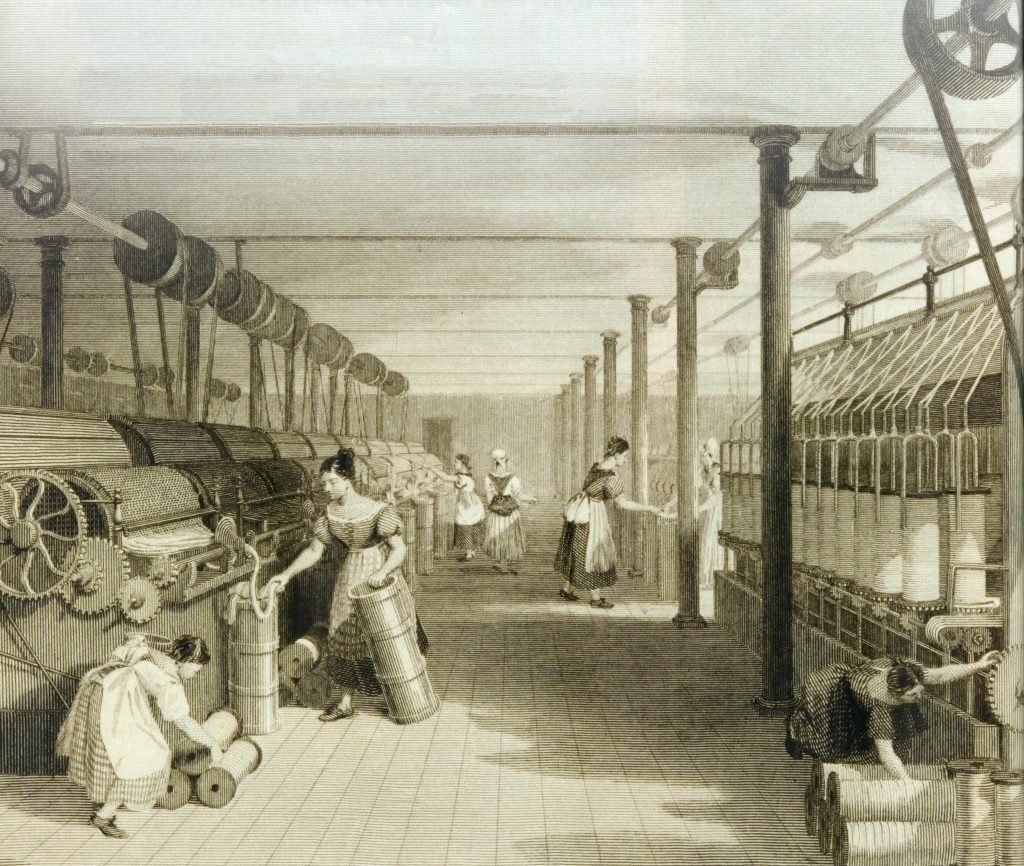Children today spend five days a week going to school for eight hours. During the first half of the nineteenth century in Britain, this was not the case. Instead, children even as young as five or six would toil all day long in factories or in mines. They had no breaks, no time off, and no schooling. Their work often led to horrible accidents, children being injured for life, and children left without an education.
Children laboring, of course, did not start with the British Industrial Revolution. It had been a normal part of life in Europe since the middle ages, when children helped their parents on farms and with household work. The people’s perception of this work, however, changed during the Industrial Revolution, since that is when people began to see this new kind of labor, factory labor, as an injustice and even criminal.1
The Industrial Revolution began in Britain during the 1780’s and rapidly changed the work process and the social relations of work. Prior to the Industrial Revolution, most people worked directly in the production of food, usually as farmers on their own farms. When textile factories began forming in the new factory cities, instead of working on their farms and making what their family needed, people left their farms and moved into the factory cities to make a living. Factory conditions of work, however, were far different from the work rhythms of farm life. In fact, they were brutal in comparison. Factory workers would typically put in between 12 and 16 hour days, working for meager wages. The machines they attended were dangerous, and the workers were often on their feet throughout the day, with perhaps a half-hour break for meals. Among these workers were children, many of whom were as young as five or six years old. Children were valued as workers for their small stature and ability to climb into small places and do things that adults often could not do. This often resulted in mutilation and the loss of appendages for many of these children.2
Children were also valued as workers by the factory owners because of the low wages that they were paid. Men were paid the most in factories, followed by women and then children. These wages, however small, were needed by the families of these children simply to survive. The parents often sent their children out to work to help pay for rent, food, and otherwise help make ends meet.3
One reason that the British public became outraged by child labor practices was the fact that children in factories were not receiving an education. Horace Mann, an American educational reformer, stated:
No greater calamity can befall us as a nation than that our children should grow up without knowledge and cultivation. If we do not prepare them to become good citizens, develop their capacities, enrich their minds with knowledge, imbue their hearts with a love of truth and all things holy, then our republic must go down to destruction as others have gone before it.4
This represents the thoughts of the British at the time, which was being echoed in the United States during its own industrial revolution. People wanted to ensure the future of their nation, which starts with the young. They believed that children should attend school for at least a while.5 This led to several laws being passed to raise the legal age of work.
In 1833, the British Parliament passed the Regulation of Child Labor law to help improve the working conditions for children in factories. The Law limited the age of workers, saying that they had to be older than nine with an age certificate to prove it, and that children 9-13 could not work for more than nine hours a day. Additionally, children 13-18 were not permitted to work longer than twelve hours a day. Along with these work-hour restrictions, the law also made school attendance a two-hour requirement, and said that children could not work at night. Fines for breaking these rules were small, however, so they were frequently violated, often with impunity.6

Many other pieces of legislation were also passed to place limits on the gender, hours, and ages of workers. The Mining Act of 1842 prevented women and girls from working in mines, and the Ten Hours Bill of 1847 set ten as the maximum number of daily working hours for women and children. This act was hated by factory owners because they believed it would hurt the textile industry’s competitiveness worldwide. After these bills, others followed to ensure their effectiveness, and to ensure that they would be properly implemented.7
By 1900, the minimum working age had been raised to twelve years of age and child labor had decreased drastically in Great Britain. However, the introduction of legislation against child labor provoked its share of protests as well. Because of these protests, Parliament established commissions to collect evidence of abusive practices. These were called the Blue Books or Sadler Reports. They interviewed children, parents, factory workers, owners, and even doctors on the condition of children in textile factories. Unsurprisingly, the reports uncovered a range of serious abuses by factory owners and overseers. Unfortunately, most critics just said that the claims were exaggerated in order to continue their money making practices.8
The legislation surrounding the British Industrial Revolution had become very effective by 1900, and child labor and its accompanying abuses had decreased dramatically. By 1900, most children were attending school instead of working in factories. The laws passed finally added up to changing British child labor to being closer to what we see today, a mostly child-free labor system, with children going to school and adults having regulated working hours.
- World History Encyclopedia, 2011, s.v. “Child Labor and Child Labor Laws in Early Industrial Great Britain.” ↵
- James D. Schmidt, “Broken Promises: Child Labor and Industrial Violence,” Insights on Law & Society, no. 3 (Spring 2010): 14–17. ↵
- Robert Whaples, “Hard at Work in Factories and Mines: The Economics of Child Labor during the British Industrial Revolution,” Business History Review, no. 2 (2001): 429. ↵
- Friends’ Intelligencer vol. 28 no. 1 (1871): 336. ↵
- James D. Schmidt, “Broken Promises: Child Labor and Industrial Violence,” Insights on Law & Society, no. 3 (Spring 2010), 14–17. ↵
- Great Britain, “Factories Regulation Act” (1833). ↵
- Steven Toms and Alice Shepherd, “Creative Accounting in the British Industrial Revolution: Cotton Manufacturers and the ‘Ten Hours’ Movement,” MPRA Paper, No. 51478 (2013), 6-8. ↵
- World History Encyclopedia, 2011, s.v. “Child Labor and Child Labor Laws in Early Industrial Great Britain.” ↵



141 comments
Antonio Holverstott
Children working with their families to help them survive in of itself is not morally wrong unless the child is not physically able to work, or they work in horrible conditions like those mentioned in this article. They were given little breaks to properly rest, given jobs in which they had no training to properly accomplish or were not able to do at all in any circumstance, and had little time to do anything else like education in subjects like theology.
Samuel Vega
There are a lot of parallels between the conditions for women and children during the Industrial Revolution in Great Britain and the United States. Both countries learned hard lessons with the exploiting of children in factories. Out of the crisis we have better labor laws for children, as well as the work force as a whole. Lessons that we learned should be a guideline for third world countries today. Children are still being victimized. There are stark images on the internet with child workers in 2019.
Danielle Slaughter
This is the second article I’ve read tonight about child labor before and during the Industrial Revolution. It is truly sobering to reflect on how far we have come in the Western world regarding our standards of labor. I feel for the children who perished or suffered serious injuries and illnesses from working in such grueling conditions in the factories and mines. Fortunately, thanks to reformers on both sides of the Atlantic, the practice of employing children ended.
Mia Morales
It is interesting to see how far social norms have come since the 1900s. It is heartbreaking to read that many children were forced to work in such awful conditions in order to provide for their families. This is an issue that we tend to see in today’s society that does not get enough recognition. Although the working conditions are not as harsh, it is still significant and should be dealt with properly.
Christopher Hohman
Nice article. Child labor laws were such a good thing for the children of the nineteenth century. It is too bad though that often times these laws did not have the teeth necessary to seriously curb child labor. I for one am glad that all children today have to do is go to school because education is so important because children are the future. It is funny that Britain and the United States were leaders in this field as they were in many aspects in the nineteenth and early twentieth century.
Danniella Villarreal
It is crazy to think people were okay with ending children at such a young ago to work in horrible conditions and with such little pay. I am happy that now there a re child labor laws that will make sure history doesn’t repeat itself. I can understand children helping out their parents with work, like cleaning the house or doing a little bit of farm work but children working in factories is taking things too far. Children should be able to get and education and have fun with kids their age, not be forced to work all day long which the possibility of serious injuries.
Luis Magana
I can relate to this article because I also began working at a young age but maybe not under the same working conditions. Children do need to live life and have a childhood because that is how wisdom and knowledge is gained. Kids really can’t be put under circumstances like that because they miss out on so much and later on they can have problems because they weren’t able to experience some things in life. The article was very well written and offered a lot of insight as to what happens in child labor.
Marina Castro
Very upsetting! I had read before about the industrial revolution and how workers were being exploited. However, reading about how children were exploited completely breaks my heart. It is so sad to know the fact that so many innocent kids were ripped off their childhood and forced to grow up. The saddest part to me, is the fact that factories like the ones that existed during the industrial revolution, still operate.
Sienna Guerra
The thought of child labor literally breaks my heart knowing that the lose their childhood because they have to help around the household. Working hard labor for few dollars is very upsetting and knowing that people were not going to fight it is saddening. The British Industrial Revolution was a difficult time but I hope history never repeats itself and makes any child work anywhere in the world.
Luke Lopez
This was a very interesting article on child labor during the British Industrial Revolution. It is terrible that children had to go to work in horrible conditions to help out their families while being payed very little. It is good that over time the working conditions improved, and the minimum working age for children has increased. Overall, this article was great in explaining child labor during the British Industrial Revolution.